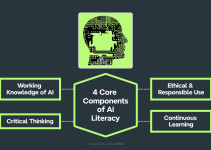AI blogging is the trend now. This era is the beginning of the end of originality and creativity among writers. Here’s my short take on how things are now after 11 years of trying to write and please the search engines so I can reach my intended audience.
Table of Contents
A Little Background on my Blogging Activity
Writing a blog can be easy, sometimes difficult, depending on what topic you are writing on and how inspired you are. At least, this is true for me, who has been doing this for more than a decade. My blogging activity is as old, even older, as this site of 11 years and 19 days. The time I spend writing depends both on my mood and the complexity of the topic I’m working on.
When I’m inspired to write, it would take me only about 30 minutes to write an article and publish it. Sometimes, it takes days of reviewing, revising, and fact checking. I see to it that I publish what I intend to express to my intended audience.
Search Engine Optimization Strategy
When I started blogging for the mere enjoyment of putting out what’s in my mind way back in 2011, I was so thrilled by seeing my articles or short notes read by other users, or bloggers. But after writing several articles online, I got to read about opportunities to earn from it. But this interest came only around five years ago, when I looked seriously about search engine optimization (SEO) strategies to enable search engines to find my articles.
I was successful then in ranking high for specific keywords I targeted, but I also came to realize that I am now writing to please the search engines, particularly Google, as a dominant search engine that brings in traffic from around the world. But things change, algorithms change, and I have to keep up, do a little tweak here and there to see how my articles performed.
Google Analytics
I spend endless hours tracking readers of my articles using Google Analytics which code I simply copy and paste in one of the plugins that I use or a specific place where that code will have to be entered. It’s straightforward.
Now, I have to contend with the complexities of having all those tags put in some place somewhere where I’m not even sure if I did it right. I experimented, to no avail. I could not get the usual view of traffic that I expected to see.
I came to ask myself: “Did I do it right? Did I paste the code to where they’re supposed to be? Did I copy and paste the correct code?” The shift to G4 Analytics is a headache to me. Things got more complex than what they were before. I need to spend more time figuring this out.
These are just some of the many questions I have now in mind nowadays, after a little over of a decade of experience studying how websites work. And I still write, occasionally right now, where I just let my mind flow to discuss this new thing that pervades online activity: AI blogging.
I wrote this article to mark the day that I realized that blogging as I used to do, is already dead. The trend now is AI blogging, or AI-assisted blogging, where the writer employs artificial intelligence to help him or her write an article.

4 AI Blogging Strategies and What to Watch Out For
While blogging and studying SEO strategies, I “discovered” new ways to write my articles or web logs. Sometimes I use them, sometimes I do not, depending on my mood and inspiration to write anything.
If not in the mood, I may rely most on what AI can do for me. But I make sure that I read everything before I publish. It’s not totally relying on the AI for all its faults. AI has problems, and I took notice so my readers will not fall victim to its hallucinations.
There are four ways that we can do AI blogging at this present moment.
Strategy 1: Let AI do the writing
As the AI app says, you can write a blog just by giving prompts to the AI on what particular topic you want it to write about. Much like we do that in our first instance of ChatGPT, we tell the AI to write an article about a particular phrase. Let it do the rest.
It pays to understand the importance of keywords as we used to do in the recommended SEO writing styles we usually do. If you are not knowledgeable of the importance of keywords and do a bit of research, chances are, you’ll miss the intended audience of your article. Your blog will be ranked in the millions, meaning, relatively few readers visit your site.
I would admit that the writing I make tries to please the search engine so that my articles will get indexed, and the intended reader will find those articles. And there are good reasons this is so. This article succinctly explains why: How to Use Keywords in Your Blogging Strategy.
The keyword strategy requires you to only think of the right keywords to use, or topics to write on, which someone somewhere is looking for information about. Ideally, it should be something that you are well familiar or knowledgeable about. That’s because you will affix your name after the AI app generates the article that you want.
The resulting article appears to be perfect. But looking closely, you realize that there is a tendency for the AI to repeat itself. Although this AI blogging strategy might work for you because you won’t mind redundancy or you can tolerate minor misinformation, it is still best to edit whatever the AI writes, as it also tells you that you need to review it for accuracy.
You will also notice that the AI uses the same phrases each time it writes an article, like putting headings starting with “understanding” or “exploring” and similar words. I think it’s a bad way of introducing a topic, so I usually remove these words from the headings. Let the headings speak about what it wrote in the section as briefly as it can do so.
Applying this AI blogging strategy will cause you to rely on the algorithms of the AI. As a longtime writer, I personally don’t like this approach. I have the option to have it directly published by the AI in this account, but I stopped short, given the errors I find in the generated articles. There is still a need for me to read the generated article line by line and then correct some errors, not only to change or delete phrases, but entire paragraphs if needed.
In my case, it takes roughly an hour to improve on the article generated by the AI, noting best SEO practices.
Strategy 2: Write your blog or article and let AI improve on it
After writing your article, you may ask the AI to improve on it. It will correct the grammatical mistakes and spelling of your composition. This approach takes more time as you write your article first hand, then ask the AI to improve on it.
This approach will take approximately two hours, primarily depending on the length of your article which, for all intents and purposes of SEO optimization, should not be less than 600 words. If it’s a topic that you get carried away, a 1,000 word article is easy to come by.
I use this approach in this article, initially thinking I’ll make it short, but I realized that while writing this article, there are many things I need to cover in AI blogging. At this point of writing, the number of words that I have written already approaches 1,300 words.
Strategy 3: Write notes and let AI organize it
You can just enter your notes and let AI organize those words in a more understandable manner. I did this approach once, using the notes I took during a meeting. The AI processed the phrases and incomplete sentences into one comprehensible document.
Still, the output needs further editing, as there are some sentences that don’t reflect what you mean. It pays to edit the finished document to correct facts, and mean what you want to say.
This AI writing strategy saves you time in organizing your notes into several logically arranged paragraphs in a formal document. This approach comes handy when you jot down notes during a field work. Thus, it pays to write your notes on your mobile phone or tablet so that you avoid missing out ineligible, handwritten notes.
Strategy 4: Prepare an outline of what you want the AI to write about
Whenever we write something and to prevent our thought from wandering about, an outline is one of our best guides. Just place important headings and, under each heading, write what the content under that heading should be. A sentence or two would make the AI generate the article the way you want it to look or sound like.
I applied this AI blogging approach in one of the articles I’ve written on this writing site. I find it satisfying as the AI composed the article based on my bidding. I let it write what should be the content of the introduction, the body, and the conclusion of the article.
Why is originality and creativity dead?
Given the four AI blogging strategies that I have enumerated in the previous section, I say that blogging with originality and creativity is dead. We can no longer subsist on our old practices, i.e., writing to enable the search engines to find our work.
We now write blogs leveraging the power of generative artificial intelligence. Gone are the days of creative writing as we know it. AI can do it better, still with us bloggers at the helm. And in order to survive in the new blogosphere, we need to employ AI for our blogging activities. If we still want to pursue our blogging interests.
Given the preference of the younger generation nowadays on video content to learn something new, there is a need to shift our focus as bloggers towards creating video content that meets the needs of viewers. I say viewers because there appears to be a preference to view videos instead of to read long lines of text.
We can still blog, but we likewise should take advantage of what AI can do. We manage these new technologies, not us managed by them.
We can still blog, but we likewise should take advantage of what AI can do. We manage these new technologies, not us managed by them.
So we take charge of the facts and let AI do the rest. We can deliver better information. With diligence and a keen eye, we can make a difference and prevent misinformation produced by those bloggers who entirely rely on AI to produce their content.
We are entirely responsible for what we write, whether it’s written entirely, or partly, by AI. As one of our unwritten ethical standards, we should STRIVE to produce factual, reliable, and well-curated content. Now, this direction is the path that this writing site will take.
As a blogger, I’d like to be part of the solution to address apprehensions about AI-caused misinformation, not add problems to the already complex world we live in today.



